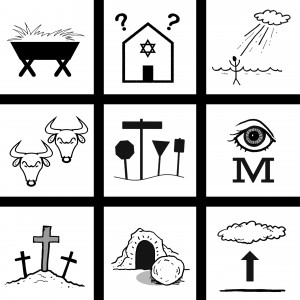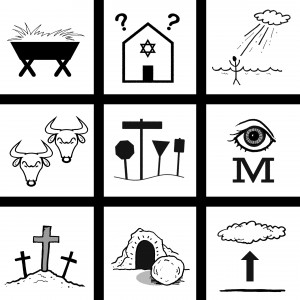 As we move into chapter six, we transition from the Old Testament to the New Testament. The New Testament begins about 400 years after Malachi (the last book of the Old Testament) was written. The New Testament covers the birth, life, and death of the long awaited Jewish Forgiver. It also gives a play-by-play, front-row view of the launch of the early church by two primary leaders: Peter and Paul. The book ends with a final snapshot of God’s view of the end of time.
As we move into chapter six, we transition from the Old Testament to the New Testament. The New Testament begins about 400 years after Malachi (the last book of the Old Testament) was written. The New Testament covers the birth, life, and death of the long awaited Jewish Forgiver. It also gives a play-by-play, front-row view of the launch of the early church by two primary leaders: Peter and Paul. The book ends with a final snapshot of God’s view of the end of time.
Many people perceive that “Old Testament God” was angry and vindictive. Others perceive Jesus as the nice guy who comes on the scene and says, “Sorry about my Dad.” After our Fast Track through the Old Testament, hopefully you came away with a different view of God. Old Testament God is the same loving, merciful, patient God found throughout the entire Bible. His nature never changes. Jesus didn’t apologize for His father. He constantly bragged about, introduced people to, and encouraged people toward His loving Heavenly Father. God loves His children and has relentlessly pursued them, longing to pour affection upon them.
The first four books of the New Testament cover the same basic material from four points of view. Matthew, Mark, Luke and John documented the period of time from Jesus’ birth to death to final resurrection. Each of them are historically-reliable, separate reports documenting the reality that Jesus lived, taught, and defeated death once and for all. Each author had a slightly different purpose and emphasis: Matthew wrote to a primarily Jewish audience and emphasized that Jesus was the long awaited King and Messiah promised by God through the prophets. Mark wrote in Greek for Roman readers, showcasing Jesus as the suffering servant, drawing attention to His others-focused life and humility. Luke, a first-rate historian and physician, wrote his report in letter form to a friend named Theophilus. Luke’s account of Jesus’ life is the result of a multi-year process of interviewing eyewitnesses, gathering evidence, and confirming historic details. John wrote his account years later for a wider audience, emphasizing the signs that proved Jesus’ claims to be God. John declares that Jesus provides the only way to truly know God, find forgiveness, and defeat death.
The theme of Jesus’ teaching is simple: don’t try to measure up, but rather look up for forgiveness. Religious leaders of the day were teaching a false interpretation of the Law. They taught that if humans tried hard enough, prayed long enough, and followed the rules closely enough, they could measure up to God’s standards. The problem with this view (besides its inherent falseness) is that it always created two emotions: fear and pride. Either you were proud that you measured up one day and looked down on others who didn’t work as hard; or you were fearful that you would never measure up and disappoint God.
Jesus showed up with a powerful message of grace that reveals a God who doesn’t take saints, but makes saints. Jesus showed a way to know God that’s not about what you do for God, but what God can do for you. He taught that a deeds-based religion falsely makes you think you look good; true grace makes God look good. Instead of presenting your “perfect” record and hoping that He accepts you, Jesus taught that God accepts you fully based on His perfect work. This message is called The Gospel, which means “good news.” (The good news of Jesus’ life is commonly called The Gospels, in reference to the central theme recorded by Matthew, Mark, Luke and John. “The Gospels” are the first four books of the New Testament.) This exciting message meant that humans could be in right standing with God! Anyone trusting and accepting this gift of grace was overwhelmed that God would provide such forgiveness and love. Instead of waiting for us to “check all the boxes,” God was going to check all the boxes for us.
The family tree of the Messiah (a.k.a. the Final Forgiver) was clearly laid out by the prophets as captured in the Old Testament. The writers of Jesus’ life carefully show us how his lineage through Mary and Joseph met the criteria laid out hundreds of years earlier. The first historic account (Matthew) begins as a woman named Elizabeth finds out she is pregnant. Her child would grow up to be known as John the Baptist and serve as the last prophet preparing the way for Jesus’ ministry. John and Jesus were cousins and born around the same time.
The Bible teaches that Jesus is both born and eternal. He is the “child who is born, but the son who is given,” according to the prophet Isaiah. Jesus was there in the beginning with God because He was God. God came to Earth in human form as Jesus by entering history through the womb of an earthly human.
An angel appeared to this young woman, Mary, to announce this supernatural pregnancy. She was surprised to be pregnant since she’d never been with a man. The angel told her that the Holy Spirit had come upon her and placed an eternal seed within her. When her fiancé Joseph heard about the pregnancy, he was deeply hurt, presuming unfaithfulness. He wanted to divorce her privately. He changed his mind, however, when an angel appeared to him confirming that the Godman was growing within Mary.

In those days, the government was taking a census which required Mary and Joseph to go to Bethlehem, since Joseph had a family tree there tracing back to King David. It was a chaotic and busy time in the small city, and when Mary and Joseph arrived, there were no hotels or inns available. Instead, as Mary went into labor, they found refuge in a stable, and used a feed trough (manger) as the newborn’s crib. Here, in this humble, smelly home for animals, God came to rescue mankind. God sent angels to announce Jesus’s birth to the shepherds nearby. They came quickly to witness the news of God’s “good will toward men.” The Creator was announcing a peace treaty to bridge the gap between Himself and humans.
God also placed a supernatural star in the sky above the family’s location. Kings from the East, probably trained by Daniel’s influence centuries ago in Babylon, saw the star and traveled to their home – just as the prophets had predicted. As the oriental kings approached Jesus, they informed King Herod of their plans to present gifts to the baby monarch. Herod searched the Old Testament to learn where this “threat to his crown” would be born. The jealous ruler dispatched soldiers to kill every male child two years or younger in Bethlehem. An angel warned the parents of the danger, and Mary and Joseph fled to Egypt for safety. It’s believed that they used the kings’ expensive gifts (gold, frankincense, and myrrh) to finance their move. After Herod’s death, the family moved back to Nazareth where Joseph worked as a carpenter.
Soon after his birth, Mary and Joseph took Jesus to the temple. There he was dedicated to God by Simeon, a man

God had told would not taste death until he saw the Final Forgiver’s birth. Jesus grew in stature, wisdom, and love for God. At age 12, on an annual trip to Jerusalem to celebrate the Passover, the young Messiah got separated from his family on the return trip. Since families and friends traveled together, Mary and Joseph assumed someone else was watching over Jesus. When they discovered he was missing, they traveled back to the synagogue and found him peppering the priests with questions. Jesus explained to a concerned Mary that he was in his “Father’s house” learning truth. The teachers were impressed by Jesus’ mature questions and insight into the Scriptures.
When Jesus turned 30, he was attending a wedding with Mary and the host ran out of wine. Mary told the serving staff to do whatever Jesus told them. Jesus knew that this miracle he was about to perform would be the launch of his public activities, thus starting the countdown to his crucifixion. Jesus turned water into wine and performed his first miracle. This was the beginning of an eventful three-year ministry.
As Jesus moved forward to launch his ministry, he met up with his cousin John at the Jordan River where the Baptist had been preaching repentance. The word repentance literally means “a change of mind.” It’s the process of turning away from self and a deeds-based religion, and instead trusting God as the authority for your life.

John the Baptist was preparing people to seek God’s forgiveness and His leadership. He was baptizing people in the Jordan who wanted to publicly declare their friendship and trust with God. As Jesus appeared at the river John announced, “Behold the Lamb of God.” People realized that John was identifying him as the ultimate substitute for the Passover Lamb, a sacrificial animal that the Hebrews used in forgiveness rituals. Jesus asked John to baptize Him as an act of public identification with God. John felt unqualified to baptize God’s son, but humbly agreed and dunked his cousin in the River. As Jesus came up out of the water, the Spirit of God descended on Him “like a dove.” A voice from heaven declared, “This is My beloved Son, in whom I am well pleased.” Jesus’ identity as the one sent by God had been confirmed by angels, prophetic predictions, Simeon, John the Baptist, a family genealogy, and now the audible words of God Himself. Faith in God is not the absence of facts, but putting your trust in God’s overwhelming evidence.
The Spirit of God immediately led Jesus into the wilderness for a 40-day period of prayer. This extended meeting with God was a preparation for the coming three years of ministry. At the end of these 40 days, Jesus was very hungry, and was tempted by an enemy to turn rocks into bread. He was offered all the kingdoms of this world if He would trust a leader other than God. This deceiver also challenged Jesus to jump off the temple to see if God would protect Him from the fall. Jesus rebuffed each of the three temptations by quoting truths from the Old Testament.
Here is a live teaching of Fast Track (Matthew-John):
For a free session of Godonomics, visit:
http://www.godonomics.com/watch-session-5

